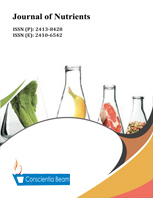Anti-Oxidative and Sensory Properties of Rice Cooked with Thaumatoccoccus Danielli Leaf Extracts
DOI:
https://doi.org/10.18488/87.v8i1.3141Abstract
The use of leaf for wrapping food is an ancient practice. Wrapping of cooked rice with Thaumatococcus daniellii have been reported to increase consumers’ appeal and functionality. There is dearth of information on exploring the use of T. daniellii leaf extract as an additive during rice cooking. This study evaluated the antioxidant and sensory properties of rice cooked with the inclusion of Thaumatococcus danielli leaf extract. Cold extraction of leaf was done using hexane, ethyl acetate, methanol, and water. The rice samples cooked with different Thaumatococcus danielli leaf extracts were analyzed for antioxidant and colour properties using standard methods. Sensory evaluation of cooked rice samples using 9-point hedonic scale was carried out by thirty-member panelists. The antioxidant properties determined were total phenolic content (0.37- 0.44 mg/g), Total flavonoid content (6.6-7.9 mg/100g), 1,1-diphenyl-2-picrylhydrazyl (29.96 -39.82%), total antioxidant capacity (3.57-4.71 mg/g), ferric reducing antioxidant power (3.93-4.37 mg/100g). The instrumental lightness (L*) measurement of cooked rice ranged from 44.13 to 53.95, redness and greenness (a*) ranged from -4.91 to -3.02, yellowness – blue (b*) ranged from 13.22 to 15.94. Sensorial assessment showed that rice cooked with water extract of T. daniellii leaf was the most acceptable. There was significant difference (p<0.05) in antioxidant, colour and sensory properties of cooked rice samples. Thaumatococcus daniellii leaf extracts increased the antioxidant properties of cooked rice and imparted a higher sensorial acceptability.

